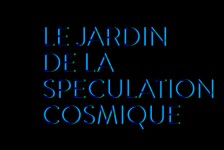Artists | Haluk Akakçe, Hüseyin Çağlayan, Arik Levy, Serkan Özkaya & George L. Legendre, Ali Emir Tapan, Evren Tekinoktay, Elif Uras, Nil Yalter
Le Jardin de la Spéculation Cosmique (Garden of Cosmic Speculation) emerges as a garden composed of artistic content. A garden of speculation on the nature of cosmos already exists in South West Scotland and is formulated by landscape architect and theorist Charles Jenks. The translations of cosmic compositions such as solitons, black holes, fractals appear as objects and installations in large scale on custom shaped trees, ponds and earth.
The exhibition Le Jardin de la Spéculation Cosmique shares the same name with Jenks’ garden, yet it differs in kind. Following a counter-action to that of Jenks’ illustrative attitude in fabricating its cosmic speculative nature: the exhibition gathers positions that produce further the existing, the given.
The pieces trigger a conceptual beyond, rather than displaying illustrations of cosmos. They differ in kind from one other in their aesthetic manifestation and subject matter; yet they conceive acts of furthering the given, the existing. Those additional dimensions constitute the cosmic fabrication of speculation.
The garden as a metaphor for an exhibition marks the structure of its constellation, as well as its mental space. An exhibition akin to that of a garden is a specification of conscious selection and exclusion of things, an organisation on an intellectual level; it contains many world-views and relations at play. Le Jardin de la Spéculation emerges as an experience succeeded by the encounter of its viewer. The exhibition, hence, brings forth a multitude, a heterogeneous togetherness of distinct bodies of work in a constellation that of which formulates an imaginary garden.
—
Le Jardin de la Spéculation Cosmique (Kozmik Spekülasyon Bahçesi) içeriğini sanatın oluşturduğu bir bahçedir. Güneybatı İskoçya’da evrenin doğası üzerine spekülatif yaklaşımı olan bir bahçe hali hazırda yer almaktadır. Peyzaj mimarı ve teorisyen Charles Jenks’in ürünü olan bu bahçe kara delikler, fraktallar gibi soyut kavramlar üzerine yoğunlaşır. Büyük bir alanda, bu kavramların ağaçlar, göller ve toprak kullanılarak oluşturulmuş tasvirleri yer almaktadır.
Le Jardin de la Spéculation Cosmique bu bahçe ile aynı ismi taşıyor olsa da, onun ürettiği biçimsel tutumu benimsemez. Sergide yer alan eserler kainatın bileşenlerinin yapısal bir tercümesi ya da temsili değildir. Aksine, sergi varolanın, gerçekliklerin yeniden üretimini bir araya getirir. Eserler, kavramsal ötelemeler üretmektedir ki, bu durum spekülasyonun kozmik bağlantısını oluşturur.
Bahçe kavramının metafor olarak konumlandığı bu sergi, bahçelerin yapısı ve düşünsel düzlemi ile de ilişkidedir. Bir sergi, tıpkı bir bahçe gibi bilinçli seçimlerin ve dışarıda bırakmaların ürünü zihinsel bir düzenlemedir; bünyesinde farklı bakış açılarını ve ilişkileri barındırır. Le Jardin de la Spéculation tektip olmayan eserlerin birlikteliğinde izleyicisi ile karşılaştığında deneyime dönüşen hayali bir bahçe düzenler.
Further Reference:
A NOTE ON SPECULATION
Marcus Steinweg
1. Hegel’s definition of speculation and speculative thinking as grasping the “unity of the difference” and as “grasping opposites in their unity, or the positive in the negative,” in short, as the “power of unification,” correlates with the experience of a disunion and an abyss that is the fundamental experience of the modern philosophy of the subject.
2. The ground itself—any kind of floor or plane of consistency—remains vaulted over the abyss of a negativity that marks the inconsistency, disunion, or diremption of a subject defined by its originary ecstasy, its self-transcendence and restlessness, its almost unstoppable turbulence; a turbulence that is part of the subject by definition, as the latter extends into the dimension of subject-closure, the sphere of everything that it is not and that, as this irreducible other, delimits its self.
3. “The Hegelian subject,” Jean-Luc Nancy writes, “is in no way the self all to itself. It is, to the contrary, and it is essentially, what (or the one who) dissolves all substance—every instance already given, supposed first or last, founding or final, capable of coming to rest in itself and taking undivided enjoyment in its mastery and property.”
4. Part of the Hegelian subject is an elementary being-outside-oneself. It is a hyperbolic subject of restlessness that is conscious of its self-alienation. It gains its dialectical meaning only by passing through its loss: the loss of meaning as much as of itself.
5. “We cannot,” Nancy concludes, “say it often enough: if Hegel has appeared time and again as the thinker of a consummation of meaning in its totality, through which the spirit, passing through nature and history, returns to itself and becomes what it truly is, that is because the thinking of this consummation has opened up and exposed itself in him—but this opening-up and exposure is at once the suspension of any property and any appropriation of meaning.”
6. It is a restless and hyperbolic totality to which this thinking opens, whose speculative nature recognizes both in equal measure: unity and diremption, identity and difference, by joining both in a higher identity.
7. The speculative identity of identity and difference marks the dialectical concern of a thinking we grasp only if, as Heidegger puts it, we conceive of this higher identity as a “living unity.”
8. “Speculation,” Heidegger notes in the manuscript for the lectures on the philosophy of German idealism he held in the summer semester of 1929, is “the operation of pure and universal reason upon itself.”
9. The fact that speculation becomes autonomous in Hegel’s thinking marks the radical difference that separates him from Kant: the hyperbolic step beyond Kantian criticism, which ties the (irrational) dynamism of reason back to the forms of understanding and intuition.

